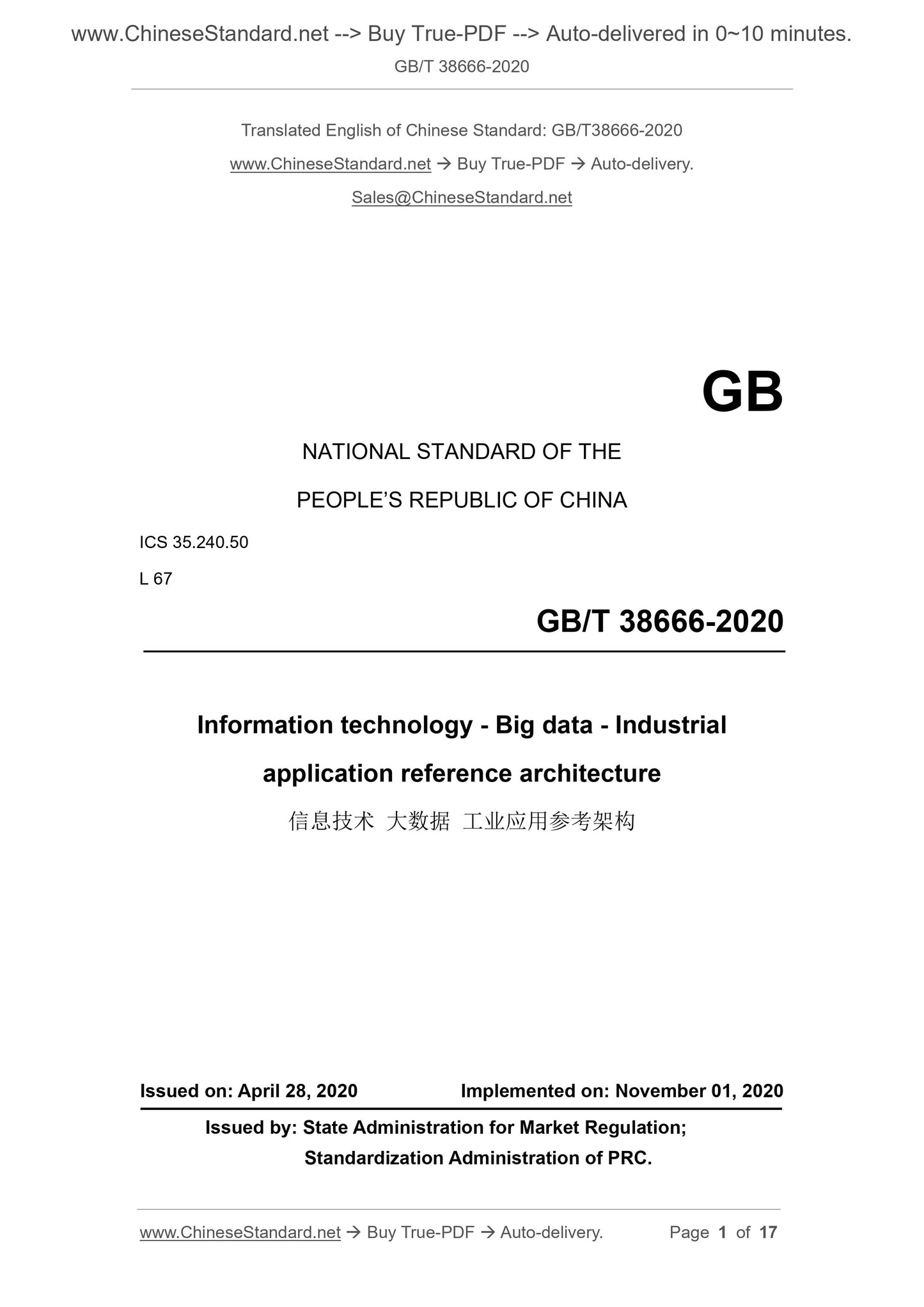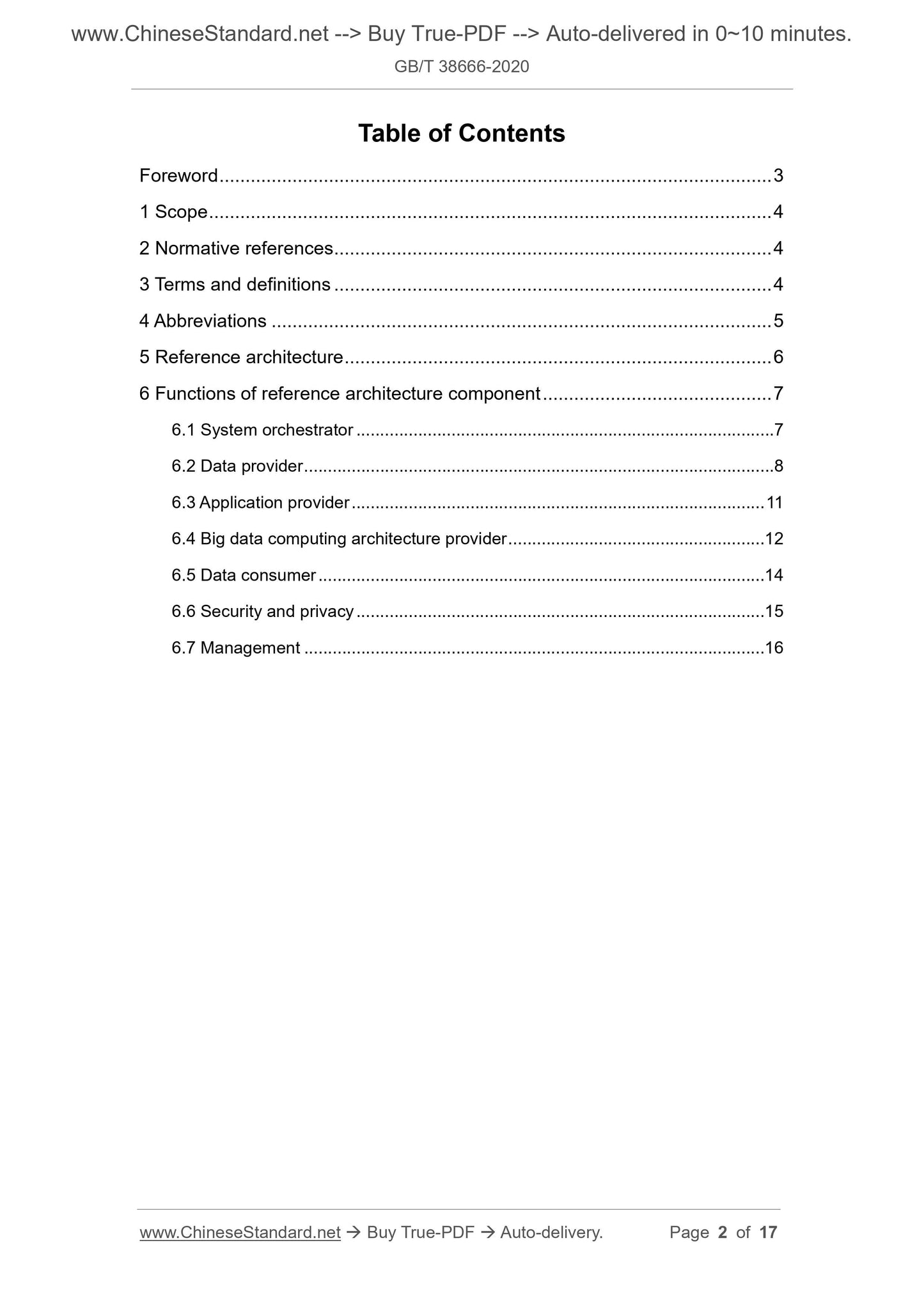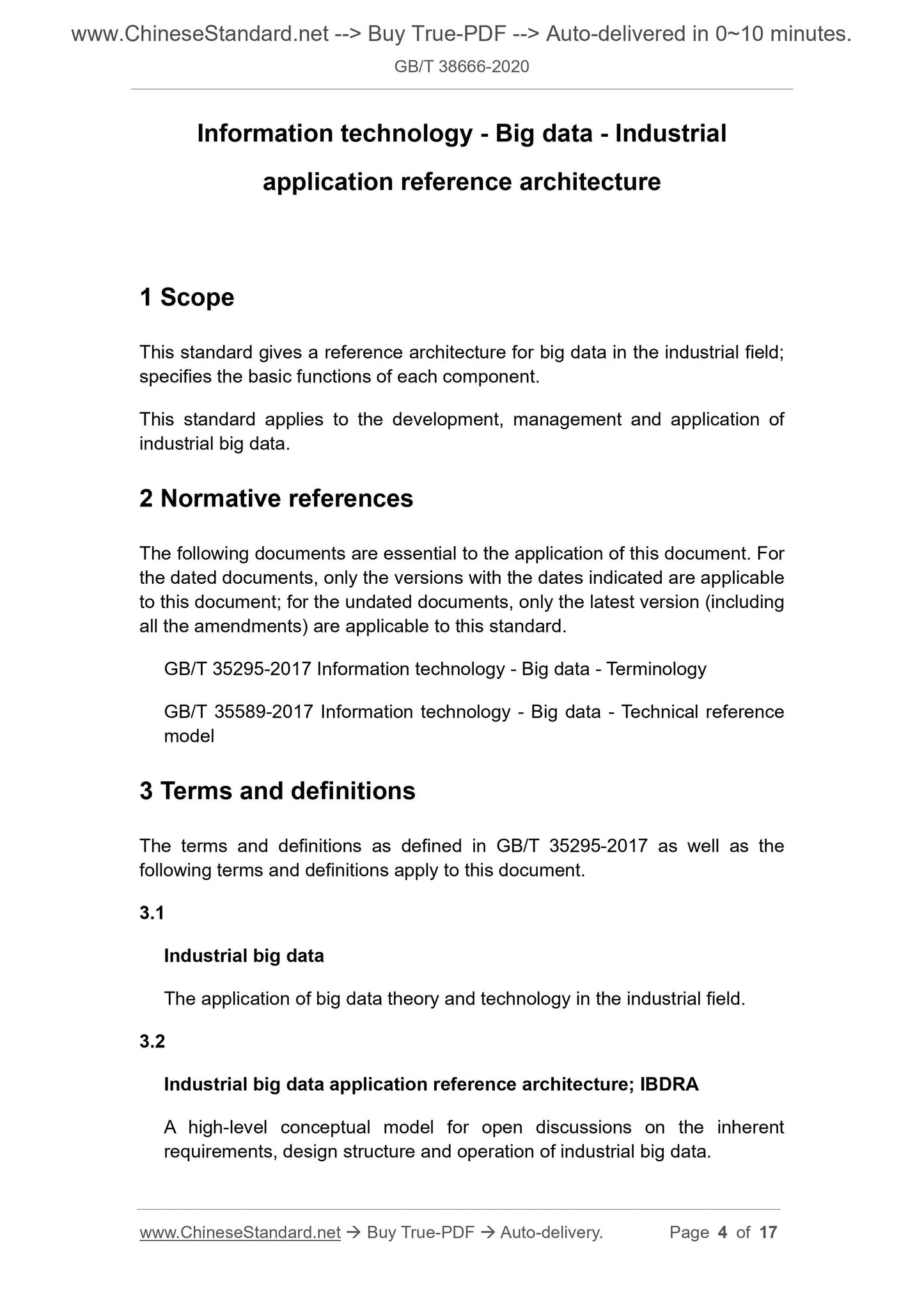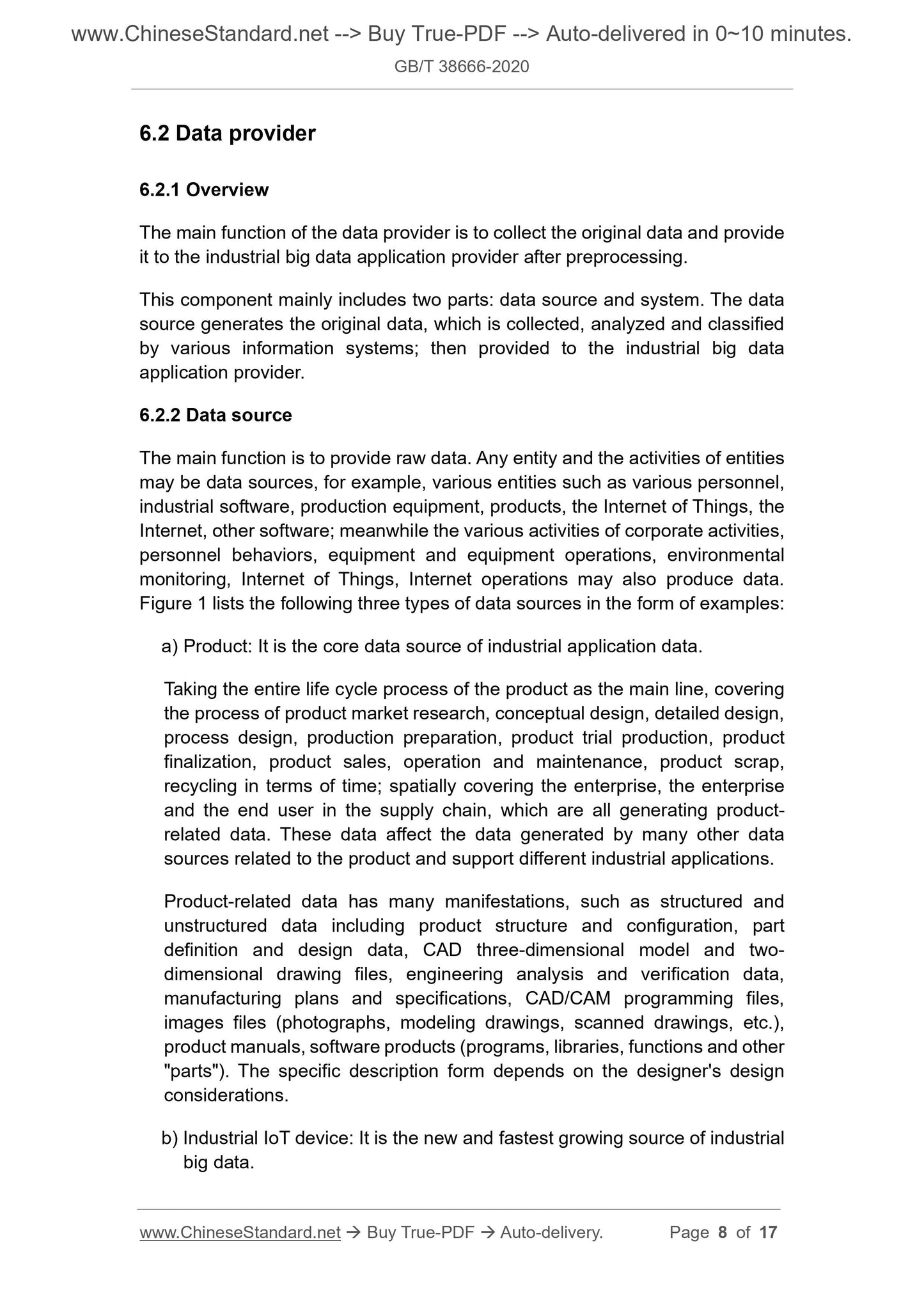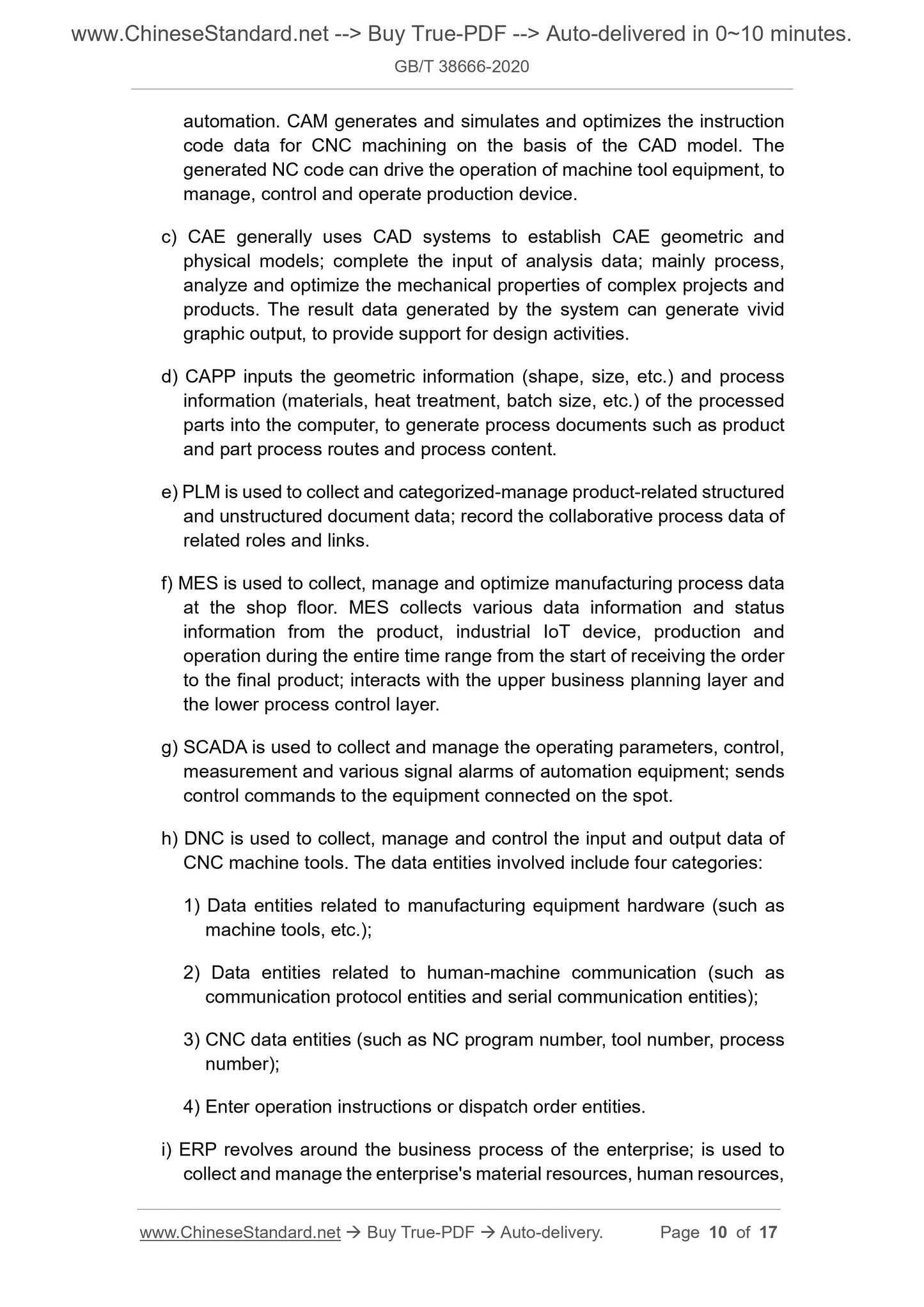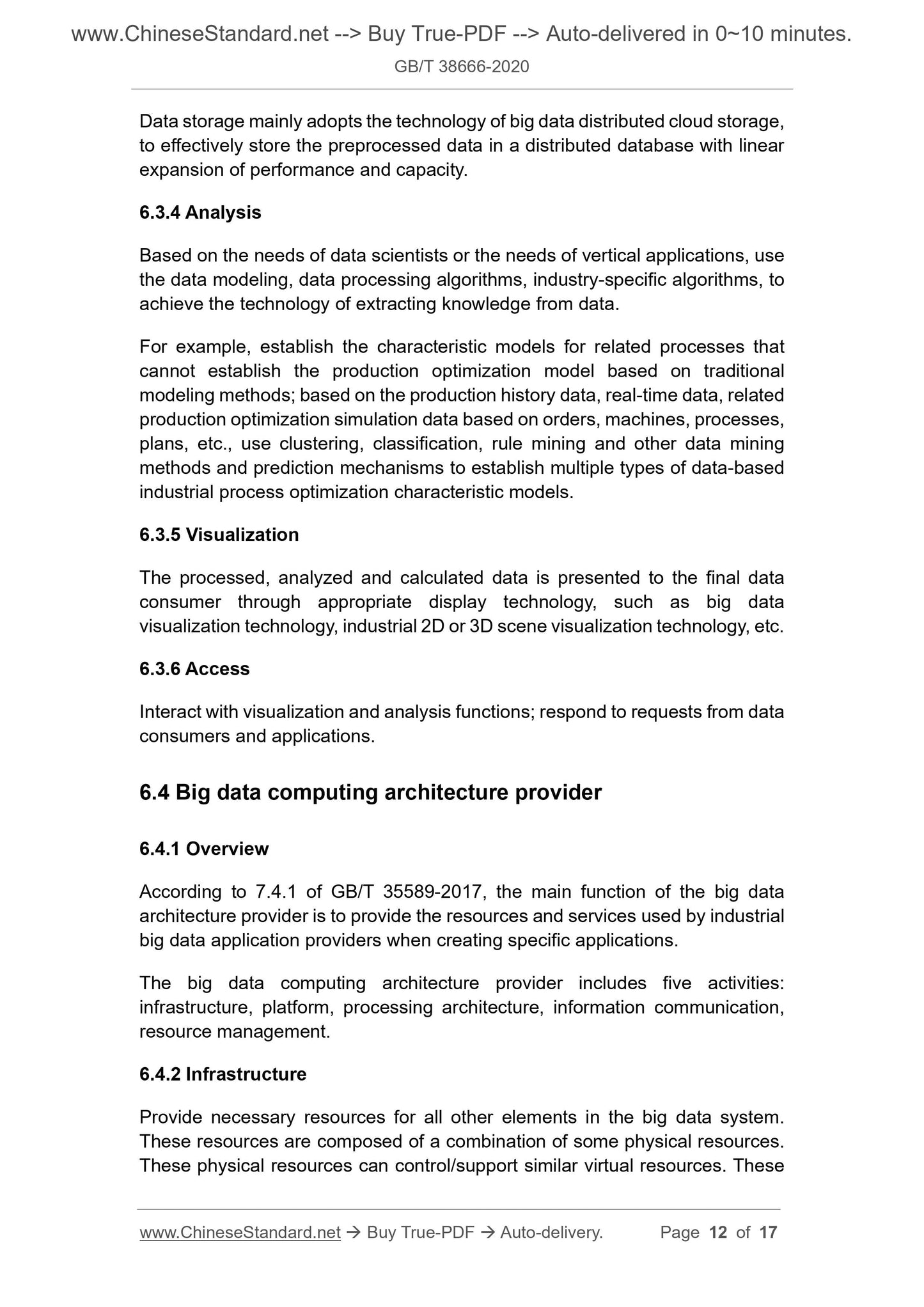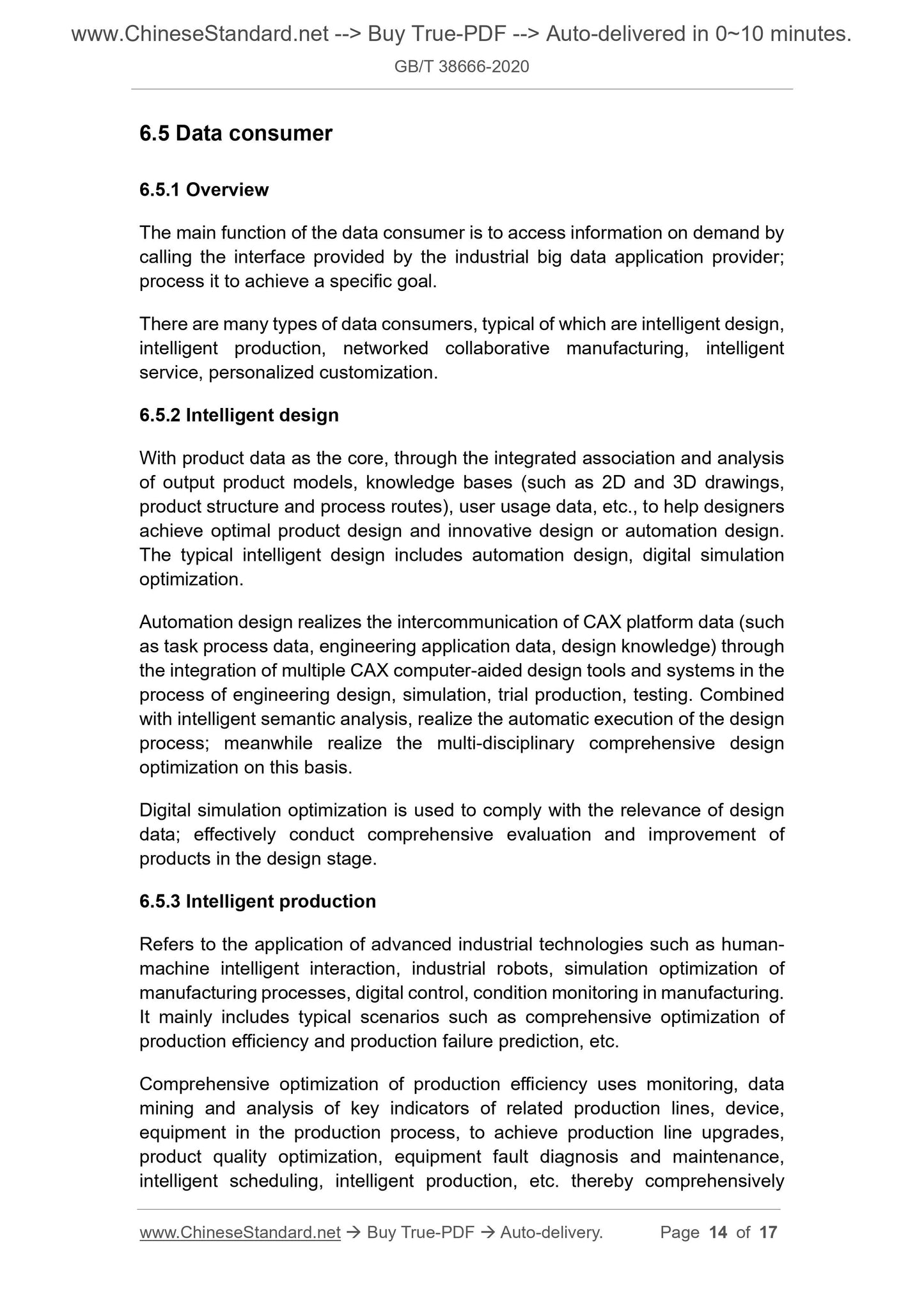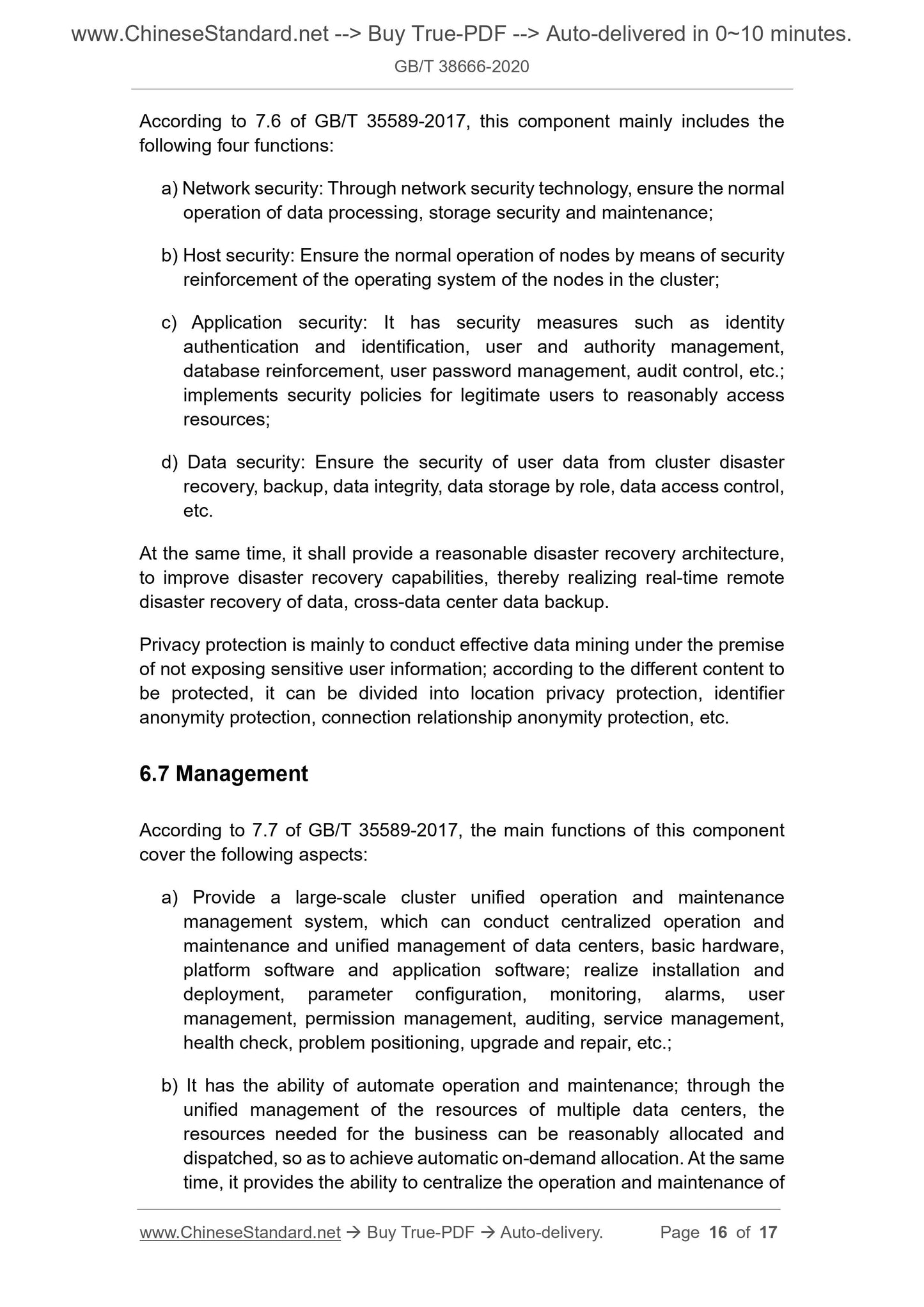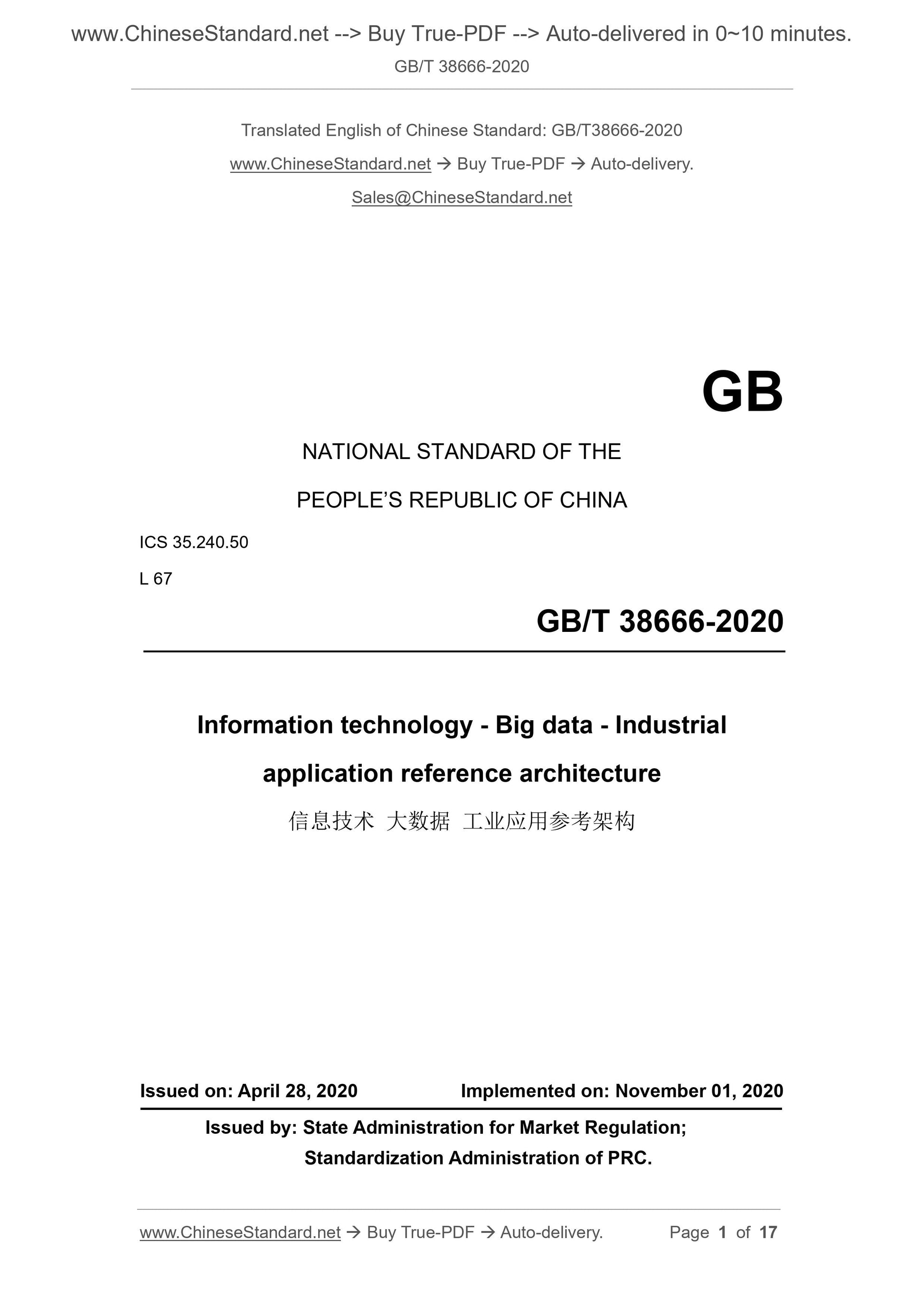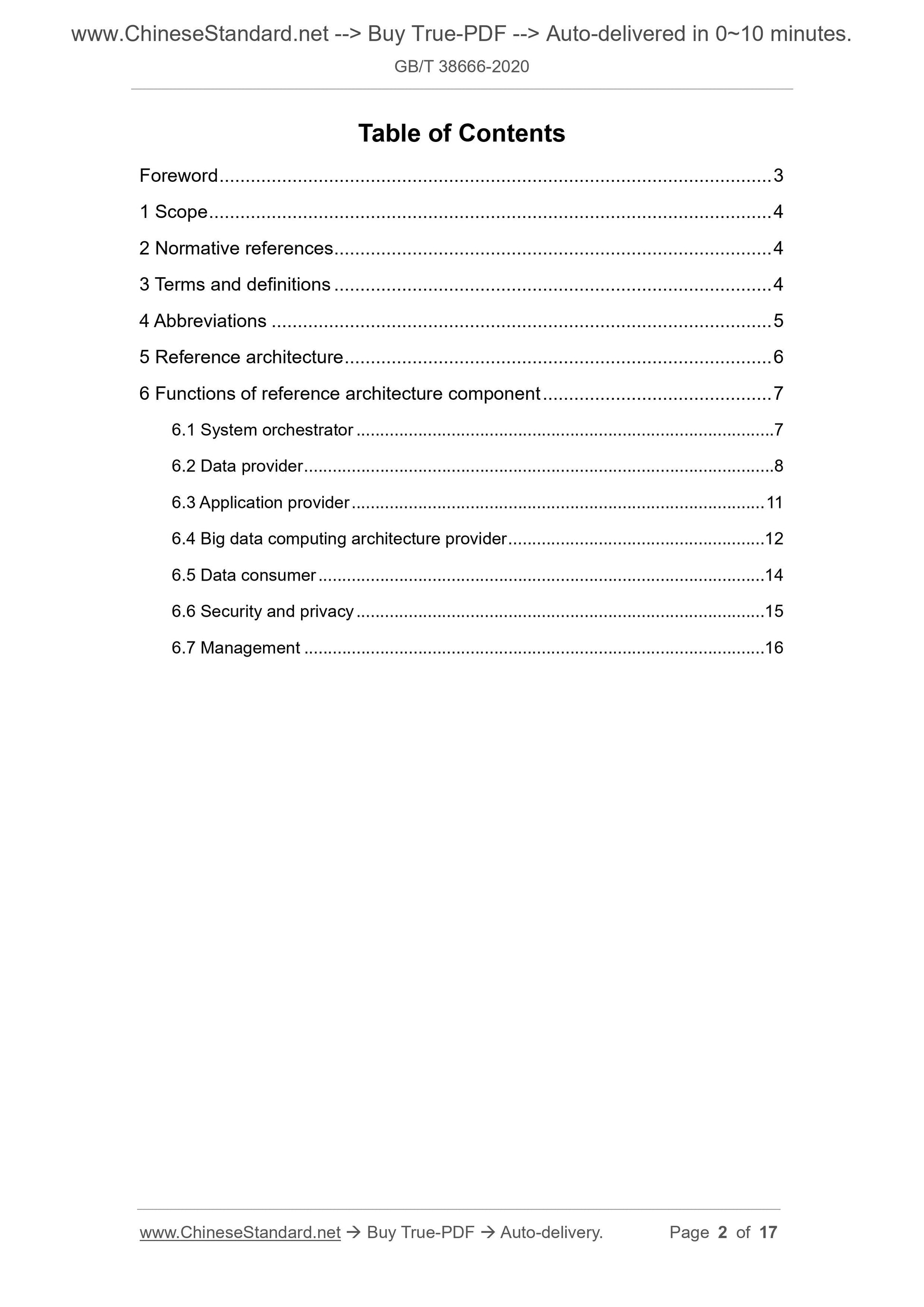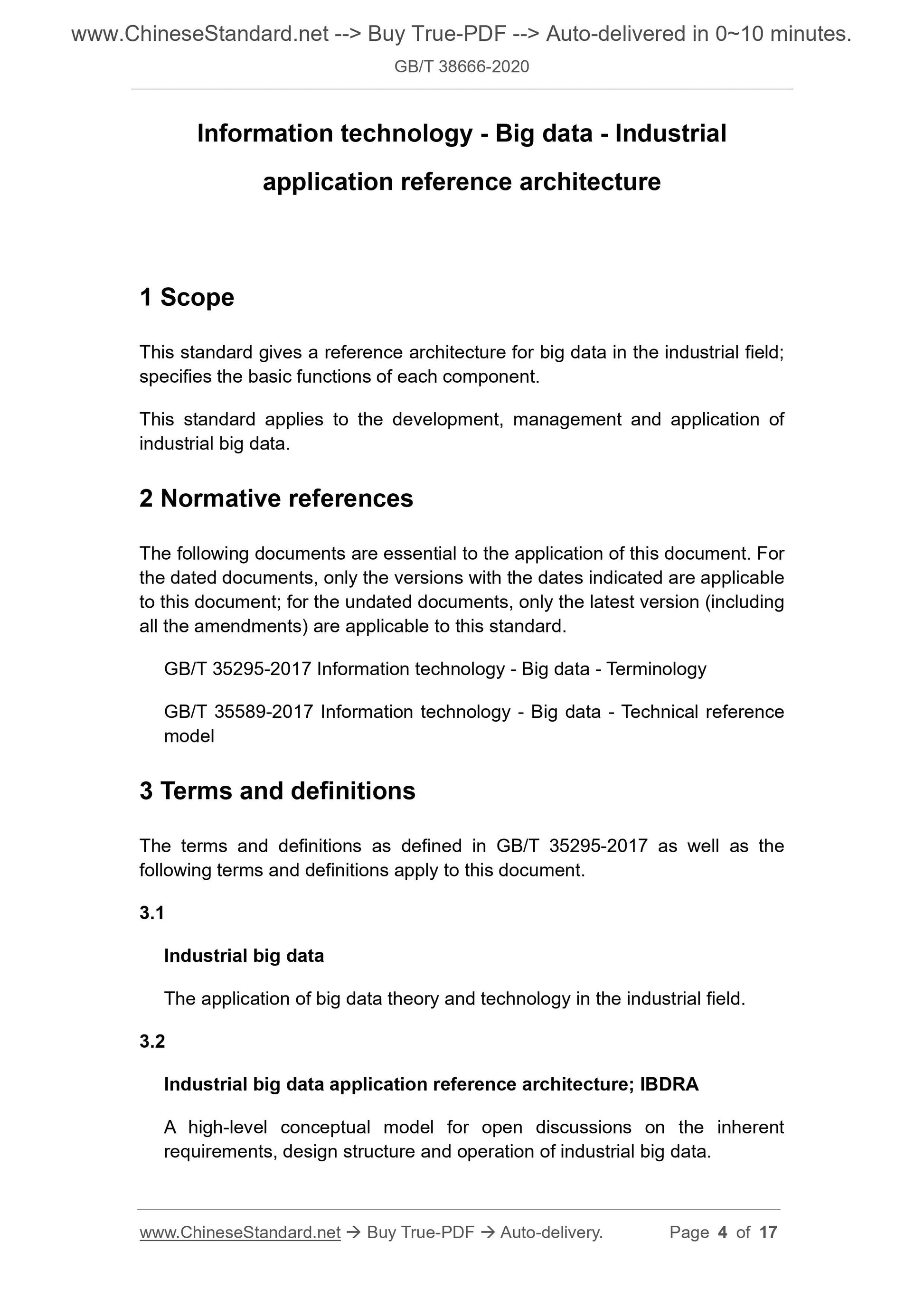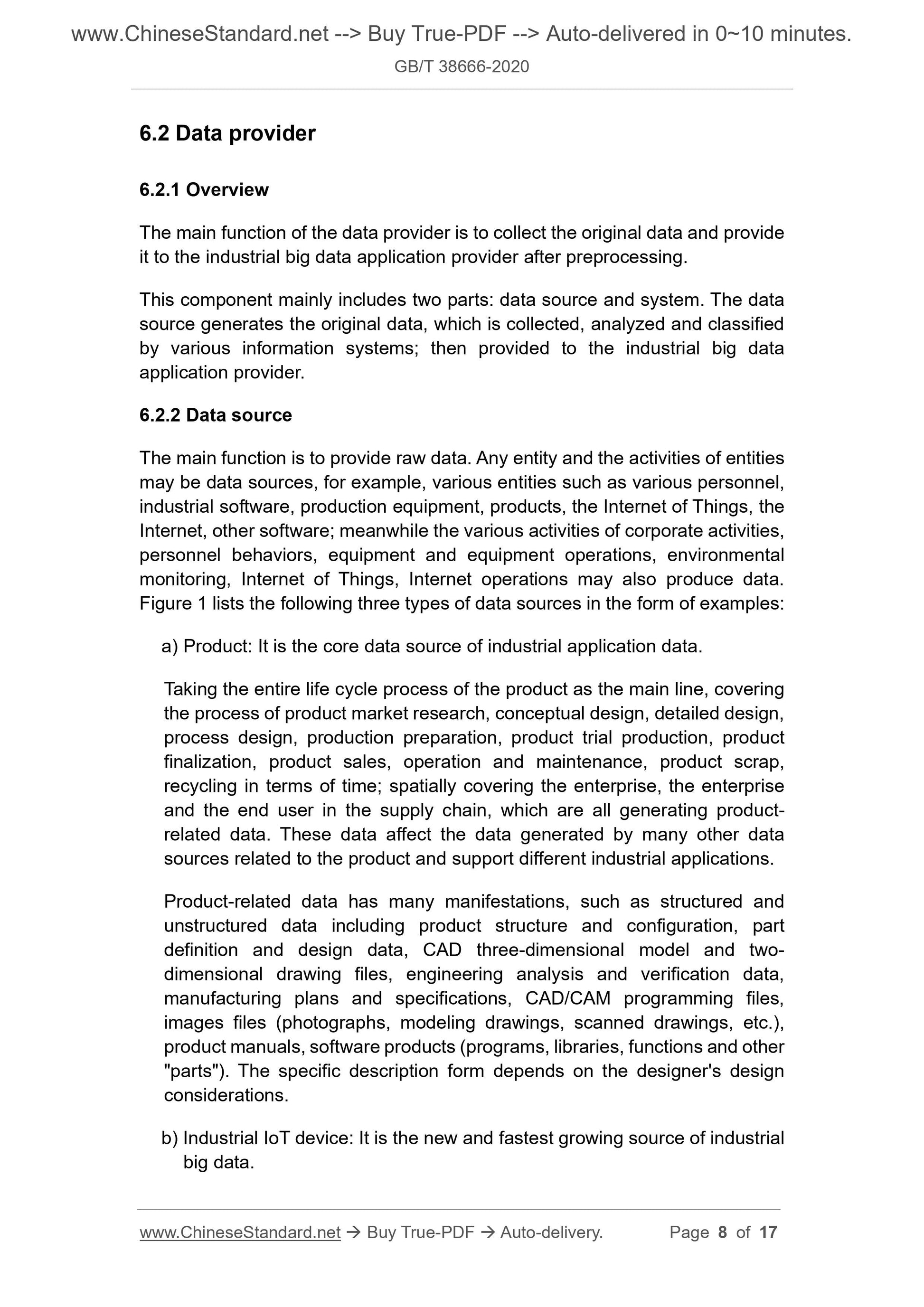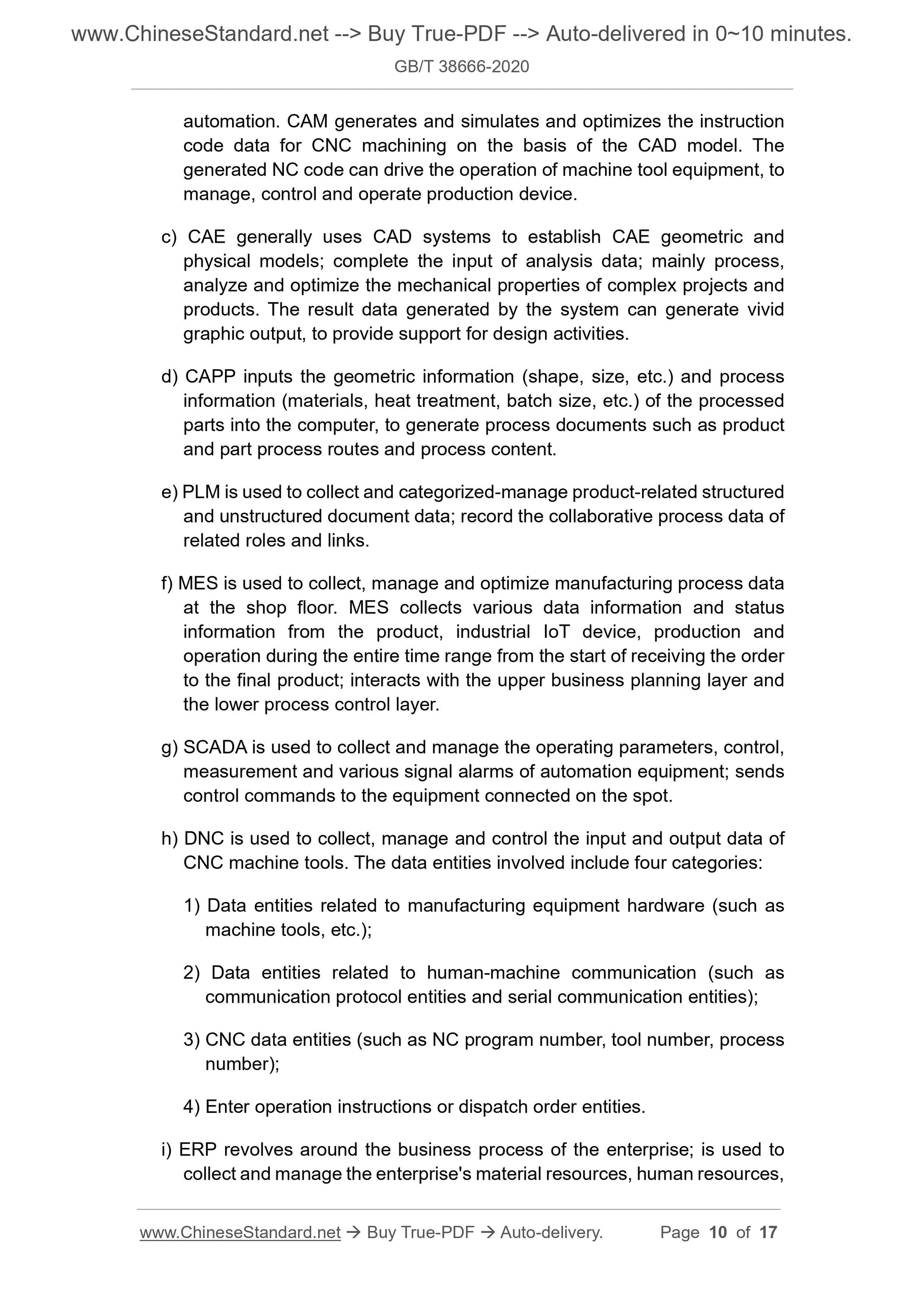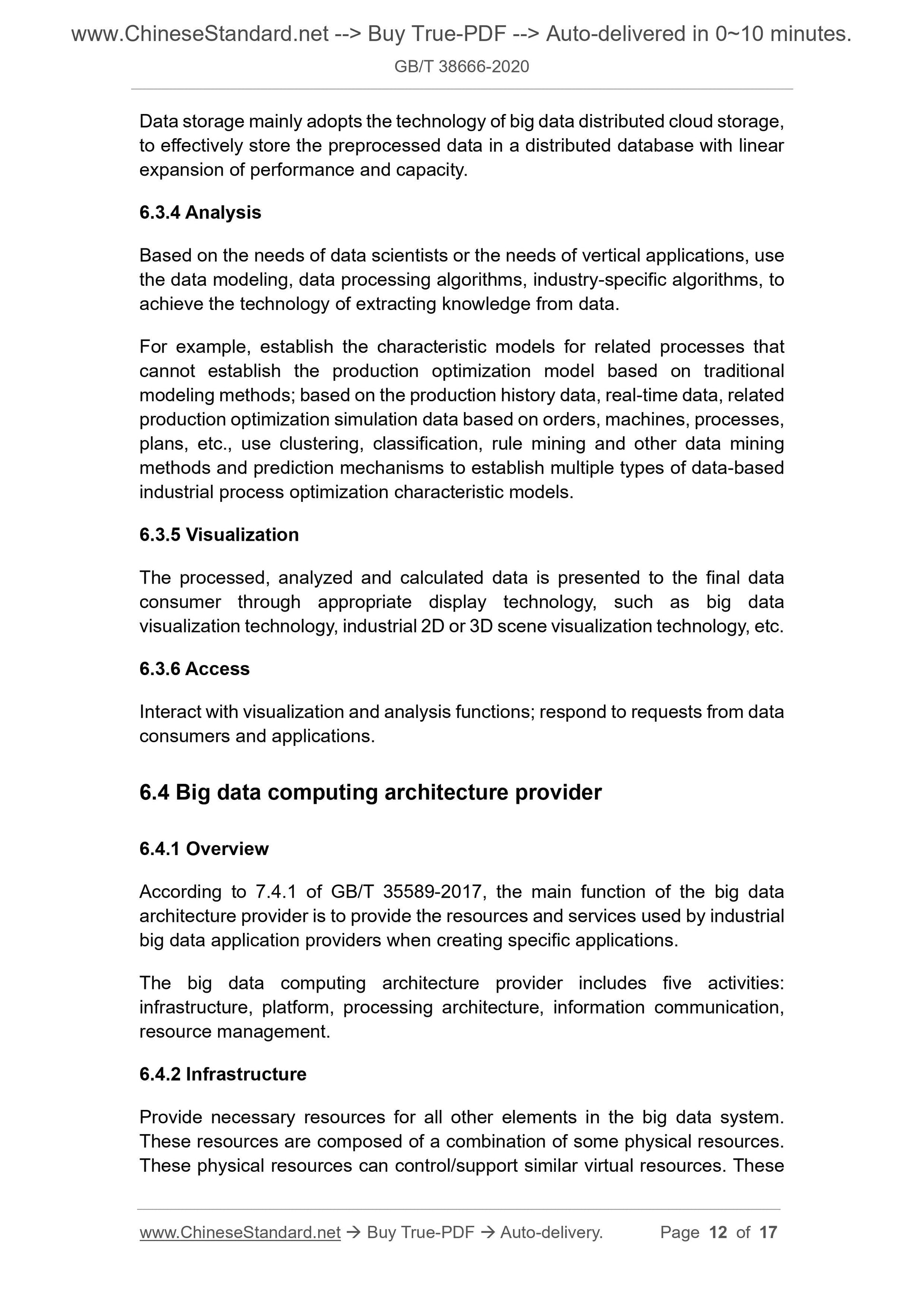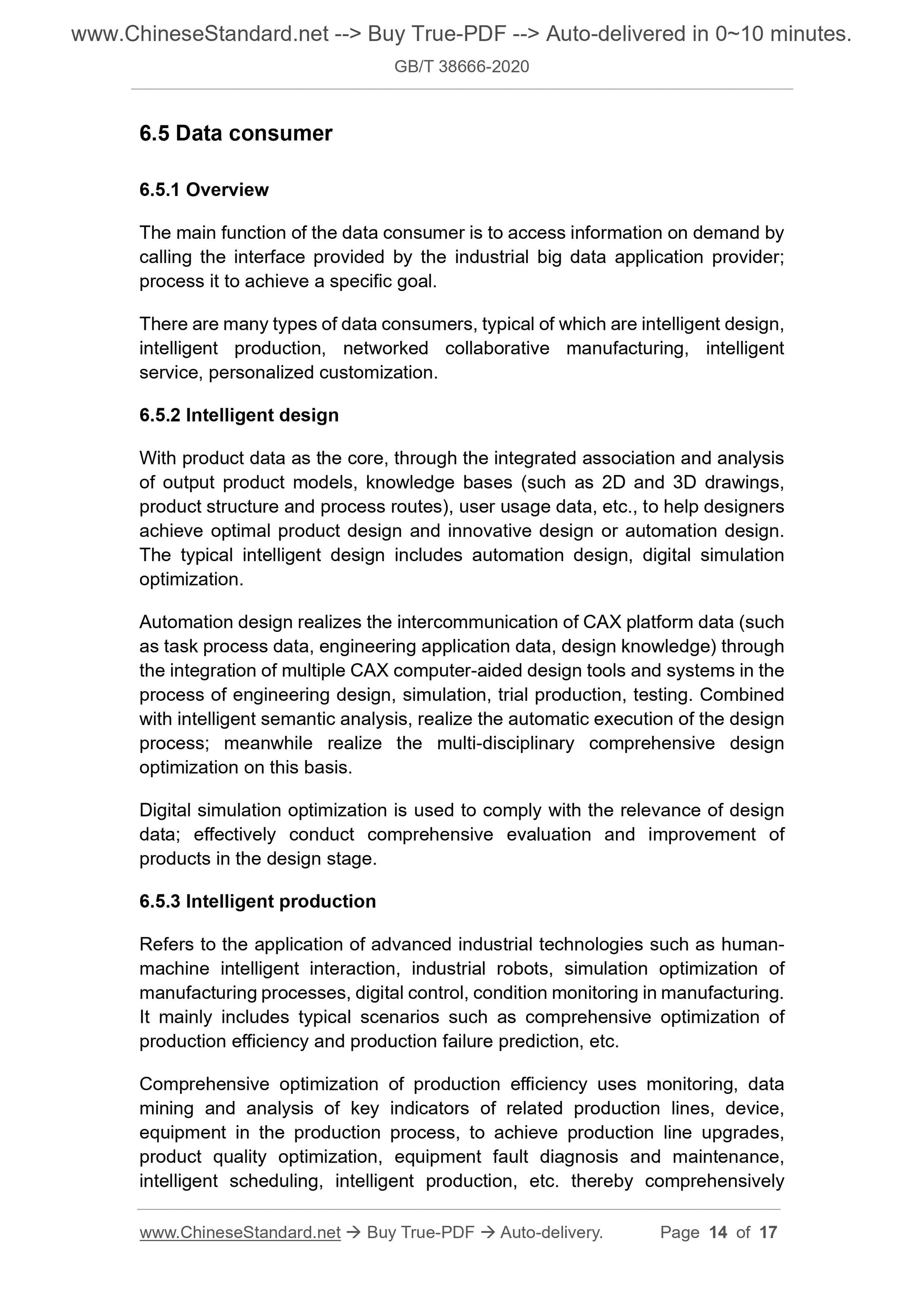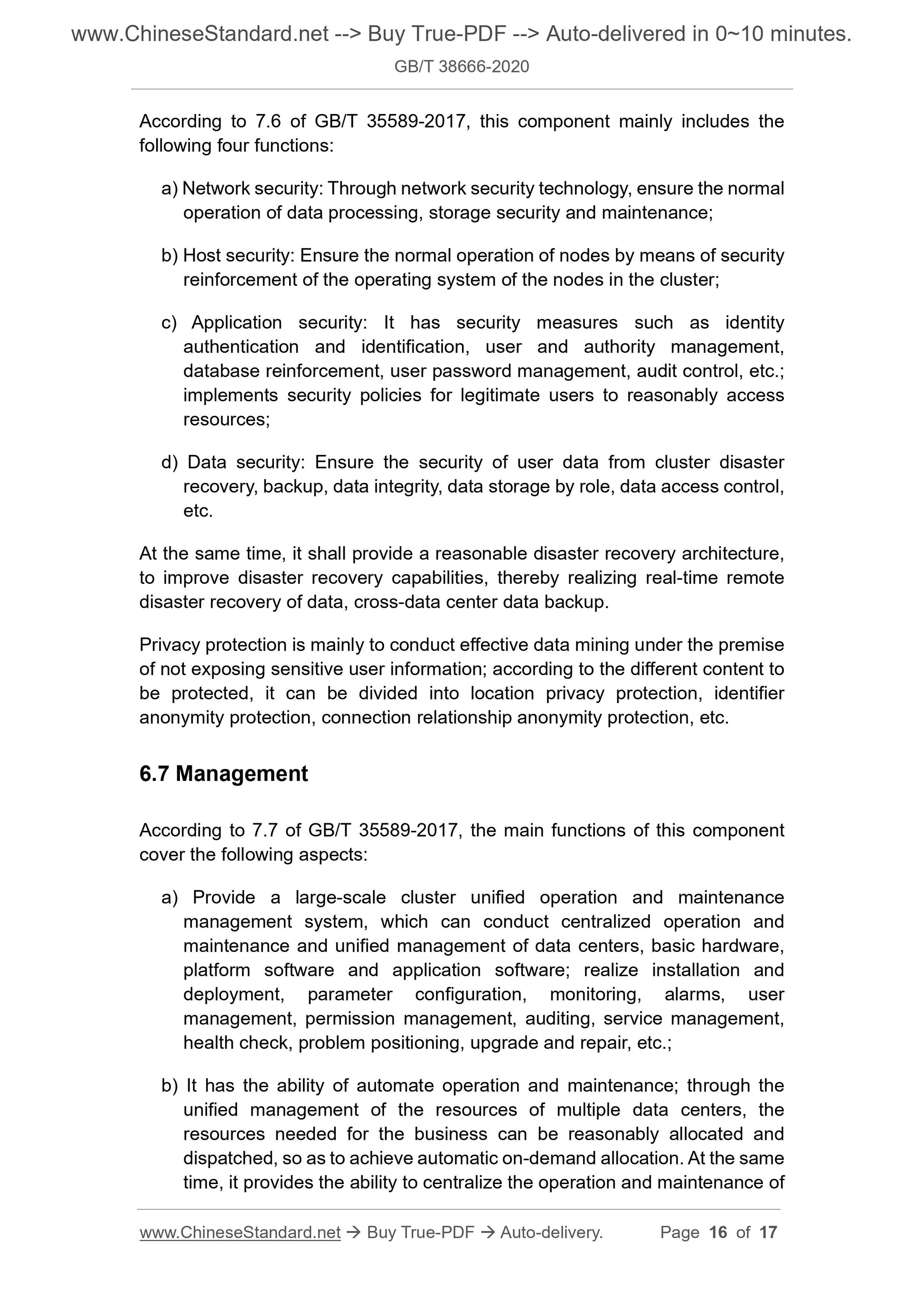1
/
of
8
PayPal, credit cards. Download editable-PDF & invoice in 1 second!
GB/T 38666-2020 English PDF (GBT38666-2020)
GB/T 38666-2020 English PDF (GBT38666-2020)
Regular price
$205.00 USD
Regular price
Sale price
$205.00 USD
Unit price
/
per
Shipping calculated at checkout.
Couldn't load pickup availability
Delivery: 3 seconds. Download true-PDF + Invoice.
Get QUOTATION in 1-minute: Click GB/T 38666-2020
Historical versions: GB/T 38666-2020
Preview True-PDF (Reload/Scroll if blank)
GB/T 38666-2020: Information technology -- Big data -- Industrial application reference architecture
GB/T 38666-2020
GB
NATIONAL STANDARD OF THE
PEOPLE’S REPUBLIC OF CHINA
ICS 35.240.50
L 67
Information technology - Big data - Industrial
application reference architecture
ISSUED ON: APRIL 28, 2020
IMPLEMENTED ON: NOVEMBER 01, 2020
Issued by: State Administration for Market Regulation;
Standardization Administration of PRC.
Table of Contents
Foreword ... 3
1 Scope ... 4
2 Normative references ... 4
3 Terms and definitions ... 4
4 Abbreviations ... 5
5 Reference architecture ... 6
6 Functions of reference architecture component ... 7
6.1 System orchestrator ... 7
6.2 Data provider ... 8
6.3 Application provider ... 11
6.4 Big data computing architecture provider ... 12
6.5 Data consumer ... 14
6.6 Security and privacy ... 15
6.7 Management ... 16
Information technology - Big data - Industrial
application reference architecture
1 Scope
This standard gives a reference architecture for big data in the industrial field;
specifies the basic functions of each component.
This standard applies to the development, management and application of
industrial big data.
2 Normative references
The following documents are essential to the application of this document. For
the dated documents, only the versions with the dates indicated are applicable
to this document; for the undated documents, only the latest version (including
all the amendments) are applicable to this standard.
GB/T 35295-2017 Information technology - Big data - Terminology
GB/T 35589-2017 Information technology - Big data - Technical reference
model
3 Terms and definitions
The terms and definitions as defined in GB/T 35295-2017 as well as the
following terms and definitions apply to this document.
3.1
Industrial big data
The application of big data theory and technology in the industrial field.
3.2
Industrial big data application reference architecture; IBDRA
A high-level conceptual model for open discussions on the inherent
requirements, design structure and operation of industrial big data.
6.2 Data provider
6.2.1 Overview
The main function of the data provider is to collect the original data and provide
it to the industrial big data application provider after preprocessing.
This component mainly includes two parts: data source and system. The data
source generates the original data, which is collected, analyzed and classified
by various information systems; then provided to the industrial big data
application provider.
6.2.2 Data source
The main function is to provide raw data. Any entity and the activities of entities
may be data sources, for example, various entities such as various personnel,
industrial software, production equipment, products, the Internet of Things, the
Internet, other software; meanwhile the various activities of corporate activities,
personnel behaviors, equipment and equipment operations, environmental
monitoring, Internet of Things, Internet operations may also produce data.
Figure 1 lists the following three types of data sources in the form of examples:
a) Product: It is the core data source of industrial application data.
Taking the entire life cycle process of the product as the main line, covering
the process of product market research, conceptual design, detailed design,
process design, production preparation, product trial production, product
finalization, product sales, operation and maintenance, product scrap,
recycling in terms of time; spatially covering the enterprise, the enterprise
and the end user in the supply chain, which are all generating product-
related data. These data affect the data generated by many other data
sources related to the product and support different industrial applications.
Product-related data has many manifestations, such as structured and
unstructured data including product structure and configuration, part
definition and design data, CAD three-dimensional model and two-
dimensional drawing files, engineering analysis and verification data,
manufacturing plans and specifications, CAD/CAM programming files,
images files (photographs, modeling drawings, scanned drawings, etc.),
product manuals, software products (programs, libraries, functions and other
"parts"). The specific description form depends on the designer's design
considerations.
b) Industrial IoT device: It is the new and fastest growing source of industrial
big data.
automation. CAM generates and simulates and optimizes the instruction
code data for CNC machining on the basis of the CAD model. The
generated NC code can drive the operation of machine tool equipment, to
manage, control and operate production device.
c) CAE generally uses CAD systems to establish CAE geometric and
physical models; complete the input of analysis data; mainly process,
analyze and optimize the mechanical properties of complex projects and
products. The result data generated by the system can generate vivid
graphic output, to provide support for design activities.
d) CAPP inputs the geometric information (shape, size, etc.) and process
information (materials, heat treatment, batch size, etc.) of the processed
parts into the computer, to generate process documents such as product
and part process routes and process content.
e) PLM is used to collect and categorized-manage product-related structured
and unstructured document data; record the collaborative process data of
related roles and links.
f) MES is used to collect, manage and optimize manufacturing process data
at the shop floor. MES collects various data information and status
information from the product, industrial IoT device, production and
operation during the entire time range from the start of receiving the order
to the final product; interacts with the upper business planning layer and
the lower process control layer.
g) SCADA is used to collect and manage the operating parameters, control,
measurement and various signal alarms of automation equipment; sends
control commands to the equipment connected on the spot.
h) DNC is used to collect, manage and control the input and output data of
CNC machine tools. The data entities involved include four categories:
1) Data entities related to manufacturing equipment hardware (such as
machine tools, etc.);
2) Data entities related to human-machine communication (such as
communication protocol entities and serial communication entities);
3) CNC data entities (such as NC program number, tool number, process
number);
4) Enter operation instructions or dispatch order entities.
i) ERP revolves around the business process of the enterprise; is used to
collect and manage the enterprise's material resources, human resources,
Data storage mainly adopts the technology of big data distributed cloud storage,
to effectively store the preprocessed data in a distributed database with linear
expansion of performance and capacity.
6.3.4 Analysis
Based on the needs of data scientists or the needs of vertical applications, use
the data modeling, data processing algorithms, industry-specific algorithms, to
achieve the technology of extracting knowledge from data.
For example, establish the characteristic models for related processes that
cannot establish the production optimization model based on traditional
modeling methods; based on the production history data, real-time data, related
production optimization simulation data based on ...
Get QUOTATION in 1-minute: Click GB/T 38666-2020
Historical versions: GB/T 38666-2020
Preview True-PDF (Reload/Scroll if blank)
GB/T 38666-2020: Information technology -- Big data -- Industrial application reference architecture
GB/T 38666-2020
GB
NATIONAL STANDARD OF THE
PEOPLE’S REPUBLIC OF CHINA
ICS 35.240.50
L 67
Information technology - Big data - Industrial
application reference architecture
ISSUED ON: APRIL 28, 2020
IMPLEMENTED ON: NOVEMBER 01, 2020
Issued by: State Administration for Market Regulation;
Standardization Administration of PRC.
Table of Contents
Foreword ... 3
1 Scope ... 4
2 Normative references ... 4
3 Terms and definitions ... 4
4 Abbreviations ... 5
5 Reference architecture ... 6
6 Functions of reference architecture component ... 7
6.1 System orchestrator ... 7
6.2 Data provider ... 8
6.3 Application provider ... 11
6.4 Big data computing architecture provider ... 12
6.5 Data consumer ... 14
6.6 Security and privacy ... 15
6.7 Management ... 16
Information technology - Big data - Industrial
application reference architecture
1 Scope
This standard gives a reference architecture for big data in the industrial field;
specifies the basic functions of each component.
This standard applies to the development, management and application of
industrial big data.
2 Normative references
The following documents are essential to the application of this document. For
the dated documents, only the versions with the dates indicated are applicable
to this document; for the undated documents, only the latest version (including
all the amendments) are applicable to this standard.
GB/T 35295-2017 Information technology - Big data - Terminology
GB/T 35589-2017 Information technology - Big data - Technical reference
model
3 Terms and definitions
The terms and definitions as defined in GB/T 35295-2017 as well as the
following terms and definitions apply to this document.
3.1
Industrial big data
The application of big data theory and technology in the industrial field.
3.2
Industrial big data application reference architecture; IBDRA
A high-level conceptual model for open discussions on the inherent
requirements, design structure and operation of industrial big data.
6.2 Data provider
6.2.1 Overview
The main function of the data provider is to collect the original data and provide
it to the industrial big data application provider after preprocessing.
This component mainly includes two parts: data source and system. The data
source generates the original data, which is collected, analyzed and classified
by various information systems; then provided to the industrial big data
application provider.
6.2.2 Data source
The main function is to provide raw data. Any entity and the activities of entities
may be data sources, for example, various entities such as various personnel,
industrial software, production equipment, products, the Internet of Things, the
Internet, other software; meanwhile the various activities of corporate activities,
personnel behaviors, equipment and equipment operations, environmental
monitoring, Internet of Things, Internet operations may also produce data.
Figure 1 lists the following three types of data sources in the form of examples:
a) Product: It is the core data source of industrial application data.
Taking the entire life cycle process of the product as the main line, covering
the process of product market research, conceptual design, detailed design,
process design, production preparation, product trial production, product
finalization, product sales, operation and maintenance, product scrap,
recycling in terms of time; spatially covering the enterprise, the enterprise
and the end user in the supply chain, which are all generating product-
related data. These data affect the data generated by many other data
sources related to the product and support different industrial applications.
Product-related data has many manifestations, such as structured and
unstructured data including product structure and configuration, part
definition and design data, CAD three-dimensional model and two-
dimensional drawing files, engineering analysis and verification data,
manufacturing plans and specifications, CAD/CAM programming files,
images files (photographs, modeling drawings, scanned drawings, etc.),
product manuals, software products (programs, libraries, functions and other
"parts"). The specific description form depends on the designer's design
considerations.
b) Industrial IoT device: It is the new and fastest growing source of industrial
big data.
automation. CAM generates and simulates and optimizes the instruction
code data for CNC machining on the basis of the CAD model. The
generated NC code can drive the operation of machine tool equipment, to
manage, control and operate production device.
c) CAE generally uses CAD systems to establish CAE geometric and
physical models; complete the input of analysis data; mainly process,
analyze and optimize the mechanical properties of complex projects and
products. The result data generated by the system can generate vivid
graphic output, to provide support for design activities.
d) CAPP inputs the geometric information (shape, size, etc.) and process
information (materials, heat treatment, batch size, etc.) of the processed
parts into the computer, to generate process documents such as product
and part process routes and process content.
e) PLM is used to collect and categorized-manage product-related structured
and unstructured document data; record the collaborative process data of
related roles and links.
f) MES is used to collect, manage and optimize manufacturing process data
at the shop floor. MES collects various data information and status
information from the product, industrial IoT device, production and
operation during the entire time range from the start of receiving the order
to the final product; interacts with the upper business planning layer and
the lower process control layer.
g) SCADA is used to collect and manage the operating parameters, control,
measurement and various signal alarms of automation equipment; sends
control commands to the equipment connected on the spot.
h) DNC is used to collect, manage and control the input and output data of
CNC machine tools. The data entities involved include four categories:
1) Data entities related to manufacturing equipment hardware (such as
machine tools, etc.);
2) Data entities related to human-machine communication (such as
communication protocol entities and serial communication entities);
3) CNC data entities (such as NC program number, tool number, process
number);
4) Enter operation instructions or dispatch order entities.
i) ERP revolves around the business process of the enterprise; is used to
collect and manage the enterprise's material resources, human resources,
Data storage mainly adopts the technology of big data distributed cloud storage,
to effectively store the preprocessed data in a distributed database with linear
expansion of performance and capacity.
6.3.4 Analysis
Based on the needs of data scientists or the needs of vertical applications, use
the data modeling, data processing algorithms, industry-specific algorithms, to
achieve the technology of extracting knowledge from data.
For example, establish the characteristic models for related processes that
cannot establish the production optimization model based on traditional
modeling methods; based on the production history data, real-time data, related
production optimization simulation data based on ...
Share
